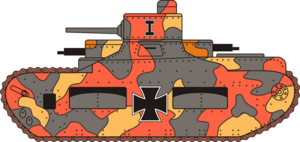| Sturmpanzerwagen Oberschlesien | |
|---|---|
 |
|
| Place of origin | Germany |
| Specifications | |
| Weight | ~19 t |
| Length | 6.7 m (7.3 yd) |
| Width | 2.34 m (2.56 yd) |
| Height | 2.9 m (3.2 yd) |
| Crew | 5 |
| Armor | 14 mm (0.55 in) |
Main
armament |
1 x 57 millimetres (2.2 in) or 37 mm (1.5 in) cannon |
Secondary
armament |
2 x 8 mm machinegun |
| Engine | Argus As III[1] 190 hp (140 kW) |
| Power/weight | 10 hp/t (7.3684 kW/t) |
Operational
range |
60 km (37 mi), ~100 km (62 mi) paved road(s)[2] |
| Speed | 16 km/h (9.9 mph) on roads 9 km/h (5.6 mph) off road |
The Sturmpanzerwagen Oberschlesien ("Upper Silesia assault armoured wagon" from German: der Sturm, the storm, the assault; German: der Panzer, gepanzert the armour, armoured; German: der Wagen the vehicle, wagon) was a German tank project of the First World War. It was a radical design for a fast-moving, lightly armored assault tank.
The Oberschlesien included a track which was placed under the tank and only wrapped around half of it. The design sacrificed armor for the sake of speed and only required a 180 hp engine for the 19 ton body, giving it a projected ground speed of 16 km/h (9.9 mph).
The tank featured such advanced features as a main cannon mounted on top of the tank in a central revolving turret, separate fighting and engine compartments, a rear-mounted engine and a low track run.
History
Towards the end of the First World War it was clear that the only operational German tank, the A7V, was too expensive to produce and had too large a crew. Therefore, it was decided that a lighter tank was required which could spearhead assaults and which could be mass-produced.Thirteen companies bid for the contract and in the middle of 1918, construction of a design by Captain Müller was assigned to the Oberschlesien Eisenwerk of Gleiwitz, which had partially completed two prototypes by October. The project received the pseudonym Oberschlesien (Upper Silesia).
Neither the ordered test models, nor the improved "Oberschlesien II" already planned were finished before the end of the war.
See also
References
| ||||||||||||||||||||||||||||||||||||||

Δεν υπάρχουν σχόλια:
Δημοσίευση σχολίου